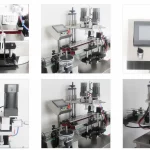
When considering renovations or upgrades to the exterior of your home, choosing the right guttering system is an important decision that should not be taken lightly. Steel guttering is a popular option that offers strength, durability, and style when installed correctly.
However, we will try to explain the benefits of metal gutters over plastic, examine the different types of metal guttering profiles available, and provide tips for proper maintenance, in this complete guide.
Importance of choosing the right guttering system for your project
Having an effective drainage system is essential to protect the structural integrity of your home’s exterior.
Steel guttering comes in various profiles to suit different roof styles and pitches.
Choosing the correct type is necessary to ensure optimal flow of rainwater off your roof and away from the building.
Benefits of metal guttering over plastic guttering
Metal options like steel delivers lasting performance without needing replacement every 5-10 years like plastic. They are less prone to cracks or leaks and generally hold their shape better over time. Although metal gutters have a higher upfront cost, they provide better long-term value through their durability and longevity.
Types of Metal Guttering
Let’s explore the most popular metal guttering materials and their key advantages:
Aluminum Gutters
At only a third of the weight of steel, aluminium gutters are lightweight and easy to install. They are a corrosion-resistant and affordable choice that won’t rust over time. Aluminium is sustainable too, as gutters can be fully recycled at the end of their lifespan.
Cast Iron Gutters
Cast iron delivers an attractive traditional appearance suitable for heritage properties. Steel-reinforced cast iron is extremely durable and long-lasting, with a lifespan of 50+ years when maintained properly. However, they are very heavy during installation.
Galvanised Steel Gutters
As the name implies, steel gutters are galvanised by coating them in a protective zinc layer. This makes them relatively affordable while resisting corrosion better than bare steel. Regular cleaning is still needed to prevent rust formation in wet weather regions.
Copper Gutters
Naturally ageing to a verdigris patina like a penny, copper gutters develop an attractive finish beauty over time. They are among the most durable gutters that require minimal ongoing maintenance. However, the material expense and risk of theft have limited their popularity versus steel options.
Zinc Gutters
Similar to copper, zinc forms a natural patina that is fade-resistant and corrosion-proof with no maintenance required. Primarily used for commercial settings, zinc gutters have a high material cost comparable to copper gutters.
Plastic Guttering
While more affordable than metal equivalents, plastic (usually UPVC) gutters have limited life spans and are prone to cracking or discolouration from UV exposure over time. They generally don’t hold up to storms as well as steel or other metal materials long-term.
Guttering Profiles
Metal gutters like steel versions come in different profiles engineered for specific use cases:
Box Gutters
With crisp corners, box profiles deliver a more contemporary aesthetic. Their enclosed design works well in areas with significant rainfall to prevent overflow.
Half Round Gutters
The classic semi-circular profile gradually funnels water toward downpipes. At 5 inches, they are versatile for most roof pitches and home styles.
Square Line Gutters
Offering drainage performance similar to half rounds, squared fronts are a popular choice for new-build properties.
Ogee Gutters
Resembling traditional 19th-century designs, ogee profiles add period charm but have narrower water capacities.
Deep Flow Gutters
Permitted for deeper water holding without spillover, these industrial-sized gutters are well-suited to large commercial buildings.
Maintaining Your Gutters
Regular maintenance is important to maximize the service lifespan of steel or other metal gutters.
Importance of regular gutter maintenance
Clogged gutters cannot efficiently drain rainwater, leading to damage issues over time from overflow/leakage. Annual cleaning prevents blockages from debris accumulation.
Steps to clean and maintain gutters
Gather necessary tools like a ladder, garden hose, and gutter cleaning tools. 2. Remove leaves/debris from the roof and gutter lengths. 3. Flush out gutters and clean any downpipe screens.
Tips for Choosing the Best Steel Guttering
When choosing the best steel guttering for your home, there are a few key factors to consider. First and foremost, opt for high-quality steel that is durable and resistant to corrosion.
Look for guttering made from galvanized steel or stainless steel, as these materials are known for their longevity and ability to withstand harsh weather conditions.
Additionally, consider the thickness or gauge of the steel. Thicker gauges generally indicate a stronger and more durable guttering system.
Another important aspect to consider is the design and style of the steel guttering. Choose a profile that complements the architecture of your home and matches your aesthetic preferences. There are various shapes and sizes available, including half-round, K-style, and box gutters.
Additionally, consider the colour options available to ensure that the guttering seamlessly blends with the exterior of your home. Lastly, don’t forget to check for warranties offered by the manufacturer, as a reliable warranty can provide you with peace of mind regarding the performance and longevity of the steel guttering system you choose.
Final Thoughts
When installed properly using high-quality materials like durable steel, gutters can safeguard your home’s exterior for decades to come. Choosing the right profile is equally important based on your property’s design features.
Consulting professional gutter installation experts can advise on product selection and answer any installation questions to deliver optimal performance and value from your new steel guttering system for many years ahead. With regular cleaning, steel gutters provide low-maintenance protection against water damage issues through all seasons and weather conditions.







